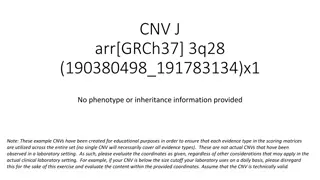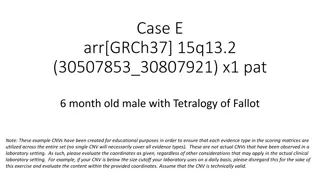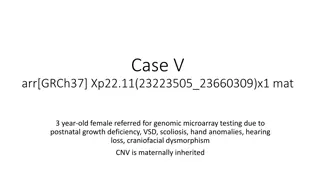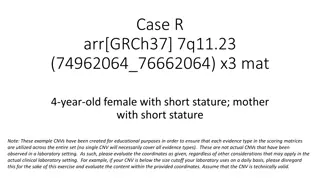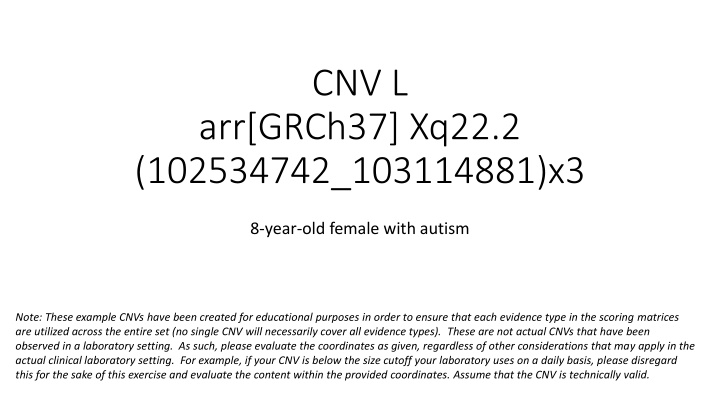
Clinical Significance of PLP1 Duplication in a Female with Autism
This case study involves a duplication of the PLP1 gene in a female with autism, highlighting the clinical implications of this variant. The duplication encompasses PLP1, a gene known to be triplosensitive and haploinsufficient, leading to PLP1-related disorders that affect central nervous system myelination. The variant is classified as pathogenic based on established evidence, demonstrating the importance of considering such genetic anomalies in clinical evaluations.
Download Presentation

Please find below an Image/Link to download the presentation.
The content on the website is provided AS IS for your information and personal use only. It may not be sold, licensed, or shared on other websites without obtaining consent from the author. If you encounter any issues during the download, it is possible that the publisher has removed the file from their server.
You are allowed to download the files provided on this website for personal or commercial use, subject to the condition that they are used lawfully. All files are the property of their respective owners.
The content on the website is provided AS IS for your information and personal use only. It may not be sold, licensed, or shared on other websites without obtaining consent from the author.
E N D
Presentation Transcript
CNV L arr[GRCh37] Xq22.2 (102534742_103114881)x3 8-year-old female with autism Note: These example CNVs have been created for educational purposes in order to ensure that each evidence type in the scoring matrices are utilized across the entire set (no single CNV will necessarily cover all evidence types). These are not actual CNVs that have been observed in a laboratory setting. As such, please evaluate the coordinates as given, regardless of other considerations that may apply in the actual clinical laboratory setting. For example, if your CNV is below the size cutoff your laboratory uses on a daily basis, please disregard this for the sake of this exercise and evaluate the content within the provided coordinates. Assume that the CNV is technically valid.
Clinical Information arr[GRCh37] Xq22.2 (102534742_103114881)x3 8-year-old female with autism No family history information is provided. Use the GAIN scoring metric
Section 1: Initial Assessment of Genomic Content Case L Genes Involved Would apply category 1A (contains protein-coding or other known functionally important elements), as this duplication includes several protein-coding genes. 0 points; continue evaluation Total: 0 points
Section 2: Overlap with Established TS, HI, or Benign Genes or Genomic Regions Case L PLP1 CNV L completely encompasses PLP1, a gene known to be both triplosensitive and haploinsufficient per the ClinGen Dosage Map. Category 2A, 1 points
PLP1 PLP1-related disorders range in severity and age of onset, but are generally characterized by defects in central nervous system myelination. Variable clinical phenotypes, even within the same family (Hodes et al. 1993; Sistermans et al. 1998) Affected females have been described In general, females within families with mildly affected males are more likely to display symptoms (compared to those families with more severely affected males) The most frequent mechanism of disease is duplication of the PLP1 gene, which occurs in CNV L No need to identify further evidence Table from GeneReviews (https://www.ncbi.nlm.nih.gov/books/NBK1182/)
Classification At this point, a variant classification has been made: Pathogenic Whole gene duplication of PLP1 is a well-established cause of PLP1- related disorders, and this is reflected in the ClinGen Dosage Map Evaluation. There is no need to search for further information to justify the classification. What is the clinical significance of this variant for this particular patient?
Clinical Significance This patient is a female. Females have been reported to manifest features of PLP1-related disorders, though it has been postulated that female duplication carriers are less likely to display symptoms than female carriers of other types of variants (GeneReviews). Patient is at minimum a carrier for PLP1-related disorders consider reporting as Pathogenic but within a carrier status section of the clinical report. Could also consider reporting as an incidental finding as it is possible for females to develop symptoms. Additional information regarding this patient s family history would be helpful in understanding risk for both the patient and other family members. This variant is unlikely to be the cause of her clinical presentation (autism). Consider additional testing to assess potential etiologies for this condition.

